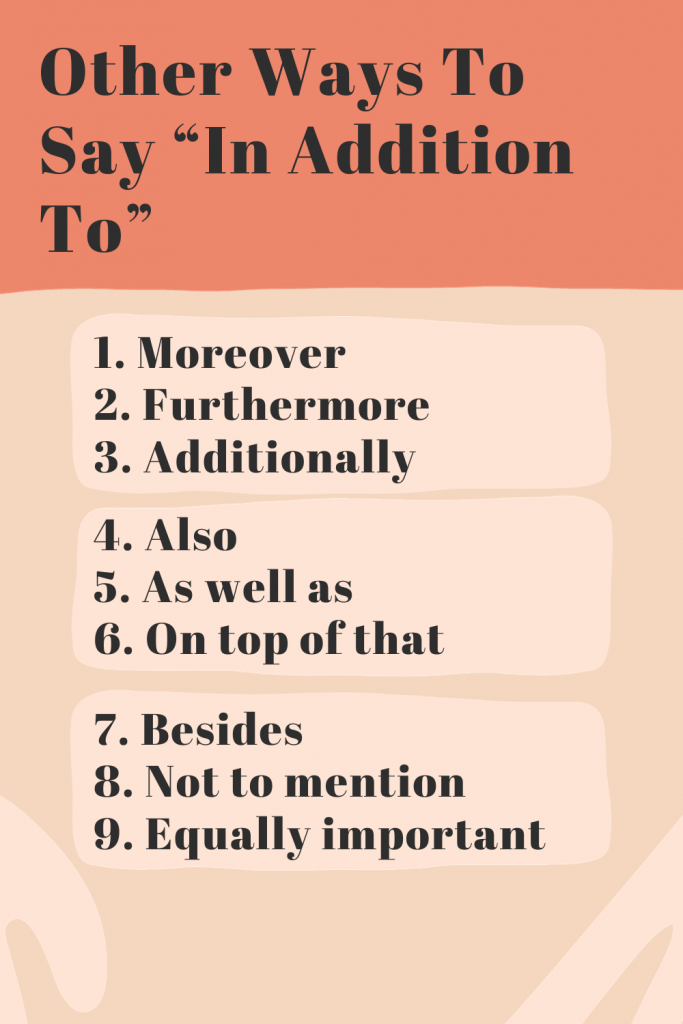When we talk or write, we oftentimes utilize the phrase in addition to bringing up another point. But we likely overuse this expression, making our language appear tedious, and rather than thoughtlessly lean on this repetitive phrase, let’s explore some alternate ways to put across this concept to liven things up. There are actually a bunch of different terms that can serve a similar purpose if we take a second to consider the options.
Alternatives to “In Addition to”
When we use the same expressions every time we show that we have a poor vocabulary. In case you are in an official meeting, this will also reflect the final result of the meeting. You will show that you are not educated enough and most likely there may not be a positive effect from the meeting.
1. Moreover
Example: “The plan is economically viable. Moreover, it’s environmentally sustainable.”
Usage: “Moreover” is used a lot in formal writing. It doesn’t just add info to the argument but boosts it too. It works great in persuasive or argument texts where each point plays off the last one to give more power to the overall message.
2. Furthermore
Example: “He is a great team player. Furthermore, his innovative ideas often lead to successful projects.”
Usage: “Furthermore” is kind of like “Moreover”, but you see it more in academic and professional stuff when adding things to make the argument stronger. It shows the thinking development and you’ll find it in presentations, reports papers when more evidence or examples are needed.
3. Additionally
Example: “The museum offers free entry for students. Additionally, guided tours are available at a reduced cost.”
Usage: Not as intense as the other two, additionally can work in formal and informal stuff and it’s good for listing multiple points or features when you are explaining something factual like in a brochure, guide, or just descriptive writing.
4. Also
Example: “She plays the guitar, and also sings beautifully.”
Usage: A more casual phrase that fits into everyday talk and writing is “also”. You use it to throw in simple facts or extra info straight up, often when listing stuff or describing things.
5. As well as
Example: “The course covers basic computing skills, as well as advanced programming.”
Usage: It’s great for items or aspects and more chill than “in addition to”. People use it when two or more pieces matter the same as what you’re talking about.
6. On top of that
Example: “He won the race, and on top of that, set a new record.”
Usage: More of a spoken thing, it piles on surprises. You see it in stories or convos where someone wants to stress another point that’s worth noting or unexpected.
7. Besides
Example: “Besides Italian, she also speaks French and Spanish.”
Usage: ‘Besides’ can be used to toss in extra stuff, kind of like an afterthought. It’s good for tacking on extra little details that might not be the main thing but still add something.
8. Not to mention
Example: “The city is known for its culture and history, not to mention its fantastic food.”
Usage: This phrase brings up more stuff like it’s pretty obvious or you already get it. It emphasizes the extra thing being said. People use “not to mention” a lot when talking or writing to highlight another point that’s assumed or especially important given the situation.
9. Equally important
Example: “Reducing carbon emissions is crucial. Equally important is the need to invest in renewable energy sources.”
Usage: You can use “equally important” to stress that some additional idea is just as big a deal as what came before. It works well in talks or arguments where you need to balance different views, like in politics, debates, or anything where you analyze stuff from all sides.
10. Not only… but also
Example: “The new policy will not only help reduce traffic congestion but also improve air quality.”
Usage: ‘Not only… but also’ is a correlative conjunction used to add emphasis to two or more equally significant points. It is particularly effective in persuasive writing or speeches, as it underscores the multifaceted benefits or aspects of a particular subject or argument.
11. To say nothing of
Example: “The car’s advanced features, to say nothing of its impressive performance, make it a great choice.”
Usage: This phrase sorta subtly suggests that the extra info coming in is pretty obvious or well-known, so it almost doesn’t need saying. It’s regularly used in persuasive or descriptive ways to subtly play up the importance or good looks of the extra point, adding some oomph to the main thing being talked about.
12. Coupled with
Example: “The hotel’s central location, coupled with its affordable prices, makes it an ideal choice for travelers.”
Usage: ‘Coupled with’ links two complementary stuff, hinting they team up to make an even better overall effect or value and this phrase is especially handy in descriptive contexts like product reviews or promo materials, where showing how different features or aspects work together is useful.
13. Last but not least
Example: “Last but not least, our software offers 24/7 customer support.”
Usage: This phrase introduces the final point in a list, stressing that even though it’s mentioned last, it’s not less important than the others. It’s commonly used in presentations speeches, and written summaries, making sure the last point is noted for its significance, regardless of its place in the sequence.

When to Use the Different “In Addition to” Alternatives
In Academic Writing:
You can use words like ‘moreover,’ ‘furthermore, or ‘additionally’ to sound really smart and make your argument clear. These terms work well when you wanna lay out a bunch of connected ideas or evidence in an organized way like in research papers or essays. They help walk through each idea one by one.
In Business Communication:
When it comes to business communication, it’s best to use phrases like ‘additionally’, ‘as well as’, or ‘also’. These help keep things professional but easy to understand – important for stuff like reports emails, presentations, etc. You want to be clear and to the point in those.
In Casual Conversations:
If you’re just chatting or posting something casual on social media, words like ‘also’, ‘on top of that’, or ‘besides’ work nicely. They introduce new points or stories in a friendly, conversational way – no need for fancy language between friends!
In Persuasive Speeches or Writing:
Now if you’re giving a big speech or trying to sell something, pull out the ‘moreover’ and ‘not to mention’. Those emphasize the really critical stuff that’ll convince people to see things your way and are useful when you really need to drive home the top benefits or arguments so the audience remembers and is persuaded. Adds some punch to get your point across.
Conclusion
When you want to add to an idea you already shared, ‘in addition to’ is a handy phrase to use. It lets you smoothly transition to make another point. This expression works well for official stuff like speeches or essays where flow matters. But saying ‘in addition to’ too much sounds repetitive. You should swap in similar phrases so you don’t sound boring. That way, your writing suits different situations―whether it’s a textbook, email to my boss, or chatting with friends, and the trick is to mix it up.
FAQs: Understanding and Using “In Addition To”
1. What does “in addition to” mean?
“In addition to” is a phrase used to introduce an additional point or item, indicating that what follows is also included or considered alongside what has been previously mentioned.
2. Is “in addition to” grammatically correct?
Yes, it’s grammatically correct and widely accepted in both spoken and written English.
3. Can “in addition to” be used in formal settings?
Absolutely. It’s particularly suited to formal writing and speeches where clarity and structured addition of points are essential.
4. When should I avoid using “in addition to”?
Avoid overusing it in any context, as this can make your language seem repetitive and unimaginative. In casual or brief communications, simpler alternatives may be more appropriate.
5. What are some synonyms for “in addition to”?
Synonyms include “furthermore,” “moreover,” “also,” “as well as,” and “besides,” among others. The choice depends on the context and tone of your message.
6. Is there a difference between “in addition to” and “as well as”?
While similar, “as well as” is often used to emphasize the equal importance of items, whereas “in addition to” tends to simply add another item to the list.
7. Can “in addition to” change the meaning of a sentence?
It can potentially change the emphasis or the flow of information in a sentence, highlighting the addition of information or items.
8. Is it appropriate to start a sentence with “in addition to”?
Yes, it can be used at the beginning of a sentence to add information to what was stated in the previous sentence.
9. Are there contexts where “in addition to” is preferred over its synonyms?
In academic and professional writing, “in addition to” is often preferred for its formal tone and clear indication of adding information.









